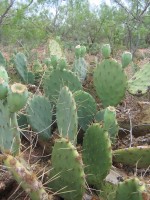
Griffiths, Bulletin of the Torrey Botanical Club 43(2): 90, 1916
Isotype; Herbarium; Herbarium; Herbarium; Herbarium (O. griffithsiana); Herbarium (O. griffithsiana); Herbarium (O. reflexa); Herbarium (O. convexa); Painting; Painting (O. convexa)
Original Description
What is Opuntia pyrocarpa?
Opuntia pyrocarpa is a commonly encountered pricklypear cactus in south-central to north-central Texas, where it often grows in deep, limestone-derived soils. It is found in Mexico and perhaps Oklahoma, and it may be in other parts of Texas.
Details
O. pyrocarpa is an ascending spreading plant to 1 m tall, but it may be lower. Often, the main branches of this pricklypear cactus are prostrate but ascend at the ends. The cladodes are large, approximately 25(30) × 15(20) cm, or they may be smaller in some plants. The cladodes may be constricted at the base to form a short neck, or this feature may be lacking. The spines curve in new cladodes outwards and down or they may be straight. Spines are present on the upper 50% to 60% of the areoles, darkening to a brown base. Spines are 2 to 3 cm long.
The flowers are yellow with light-red centers or pure yellow. This Opuntia has a white style tipped with a pale stigma. The petals are irregularly cleft or even nearly bifurcated. The fruit is pyriform or long-pyriform, and various shades of carmine, often with a purplish tinge outside and inside.
Ploidy is unknown.
Other Notes
O. pyrocarpa may form large plants that create piles of cladodes spread over 6-8 feet, making up for lack of height by achieving breadth. Or prostrate ascending branches may reach upwards to 80 cm. Several large plants growing together can create a formidable thicket. The species occurs along with other large pricklypears found in Texas, such as O. lindheimeri and O. orbiculata as well as multiple small species. Because it can form a large plant, O. pyrocarpa is confused with O. lindheimeri in parts of Texas, even though it is not upright. Also, O. pyrocarpa lacks the characteristic all-yellow spines of O. lindheimeri. The type location is Marble Falls, Texas.
O. pyrocarpa is synonymous with O. convexa, O. riparia, and O. grifithsiana.
For more information, see:
Green C.W. and Ferguson D.J. (2011) PricklyPears Commonly Found in the United States and Canada. First ed. Worldcat.org No. 827221200.































